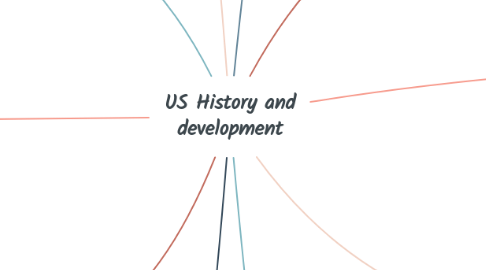US History and development
by Angelika Brungardt

1. 4. Formation of the United States (1783-1815)
1.1. Constitutional Convention (1787): The U.S. Constitution was drafted, establishing the framework of the federal government.
1.2. Bill of Rights (1791): The first ten amendments to the Constitution were ratified, guaranteeing individual freedoms.
1.3. Louisiana Purchase (1803): The U.S. doubled in size after purchasing the Louisiana Territory from France.
1.4. War of 1812 (1812-1815): A conflict with Britain that solidified American independence and nationalism.
2. 7. Industrialization and the Gilded Age (1877-1900)
2.1. Transcontinental Railroad (1869): Completion of the railroad connected the East and West coasts, spurring economic growth.
2.2. Gilded Age: A period of rapid industrialization, urbanization, and immigration, alongside political corruption and economic inequality.
2.3. Labor Movements: Growth of labor unions and strikes in response to poor working conditions and economic disparities.
3. 8. Progressive Era and World Wars (1900-1945)
3.1. Progressive Reforms (1900-1920): Efforts to address social injustices, economic inequality, and political corruption, including women's suffrage.
3.2. World War I (1917-1918): The U.S. entered the war on the side of the Allies, contributing to the defeat of the Central Powers.
3.3. Roaring Twenties: A decade of economic prosperity and cultural change, followed by the stock market crash of 1929.
3.4. Great Depression (1929-1939): A severe economic downturn that led to widespread unemployment and poverty.
3.5. New Deal (1933-1939): A series of programs initiated by President Franklin D. Roosevelt to combat the Great Depression.
3.6. World War II (1941-1945): The U.S. played a crucial role in the Allied victory after entering the war following the attack on Pearl Harbor.
4. 9. Cold War Era (1945-1991)
4.1. Marshall Plan (1948): U.S. aid to rebuild Europe after World War II, part of the strategy to contain communism.
4.2. Korean War (1950-1953): A conflict between North and South Korea, with the U.S. supporting the South against communist North Korea and China.
4.3. Civil Rights Movement (1950s-1960s): A struggle for social justice and equality, leading to significant legal and social changes, including the Civil Rights Act of 1964.
4.4. Vietnam War (1955-1975): A controversial war in Southeast Asia that deeply divided American society.
4.5. Space Race (1957-1969): Competition between the U.S. and the Soviet Union, culminating in the U.S. landing the first man on the moon in 1969.
5. 10. Modern Era (1991-Present)
5.1. End of the Cold War (1991) The dissolution of the Soviet Union marked the end of the Cold War, leading to a unipolar world with the U.S. as the dominant superpower.
5.2. September 11 Attacks (2001): Terrorist attacks on the U.S. led to the War on Terror and conflicts in Afghanistan and Iraq.
5.3. Great Recession (2007-2009): A severe global economic downturn that had significant impacts on the U.S. economy.
5.4. Technological Revolution: Rapid advancements in technology, particularly in computing, the internet, and communication, transformed society.
5.5. Social Movements and Political Polarization: Ongoing social movements (e.g., LGBTQ+ rights, Black Lives Matter) and increasing political polarization have characterized recent decades.
6. 6. Civil War and Reconstruction (1861-1877)
6.1. Civil War (1861-1865): A devastating war between the Northern states (Union) and Southern states (Confederacy) primarily over slavery and states’ rights.
6.2. Emancipation Proclamation (1863): Issued by President Abraham Lincoln, it declared the freedom of slaves in Confederate states.
6.3. Assassination of Abraham Lincoln (1865): Lincoln was assassinated shortly after the war, impacting Reconstruction efforts.
6.4. Reconstruction Era (1865-1877): The period of rebuilding the South and integrating freed slaves into society, marked by significant political and social challenges.
7. 5. Westward Expansion and Antebellum Period (1815-1861)
7.1. Monroe Doctrine (1823): A U.S. policy opposing European colonization in the Americas.
7.2. Trail of Tears (1838-1839): Forced relocation of Native American tribes from the Southeast to territories west of the Mississippi River.
7.3. California Gold Rush (1848-1855): Mass migration to California following the discovery of gold
7.4. Compromise of 1850 and Kansas-Nebraska Act (1854): Attempts to resolve conflicts between free and slave states.
8. 3. American Revolution (1775-1783)
8.1. Boston Tea Party (1773): Colonial protest against British taxation, which escalated tensions.
8.2. Declaration of Independence (1776): The thirteen colonies declared independence from Britain, leading to the Revolutionary War.
8.3. Battle of Saratoga (1777): A turning point in the war, leading to French support for the American cause.
8.4. Treaty of Paris (1783): The war officially ended with the recognition of American independence.
9. 2. Colonial America (1607-1776)
9.1. Jamestown Settlement (1607): The first permanent English settlement in North America was established in Jamestown, Virginia.
9.2. Plymouth Colony and the Pilgrims (1620): The Pilgrims, seeking religious freedom, established Plymouth Colony in present-day Massachusetts.
9.3. Thirteen Colonies: Over time, thirteen British colonies were established along the East Coast, each with distinct economies and societies.
9.4. French and Indian War (1754-1763): A conflict between Britain and France in North America that led to British dominance over the continent, setting the stage for colonial unrest.
10. 1. Pre-Colonial and Early Settlement (Before 1607)
10.1. Native American Civilizations: Before European contact, diverse Native American cultures thrived across North America, with significant civilizations such as the Mississippian culture and the Iroquois Confederacy.
10.2. Norse Exploration (c. 1000 AD): Leif Erikson and other Norse explorers are believed to have reached parts of North America, such as Newfoundland (Vinland).


